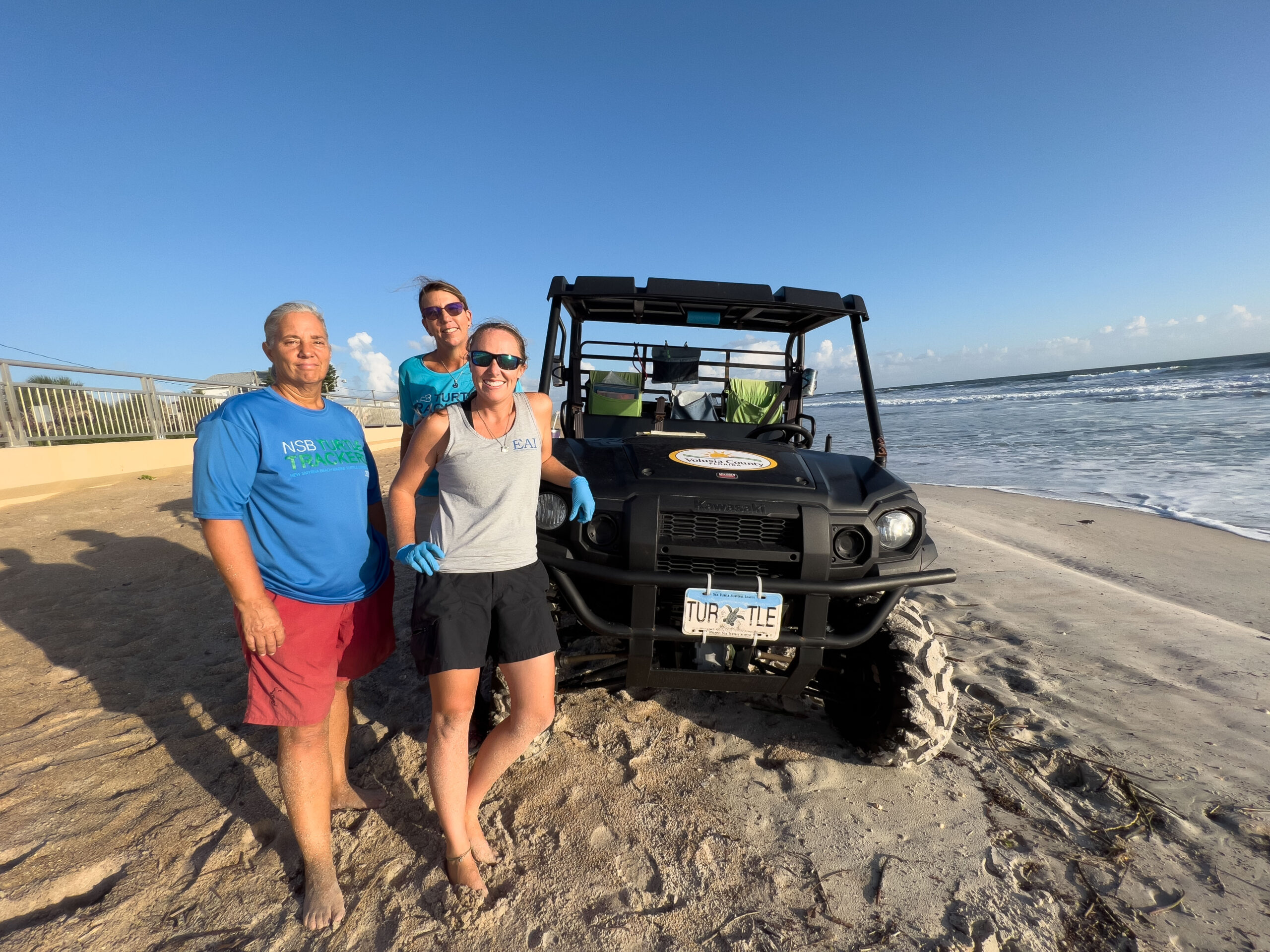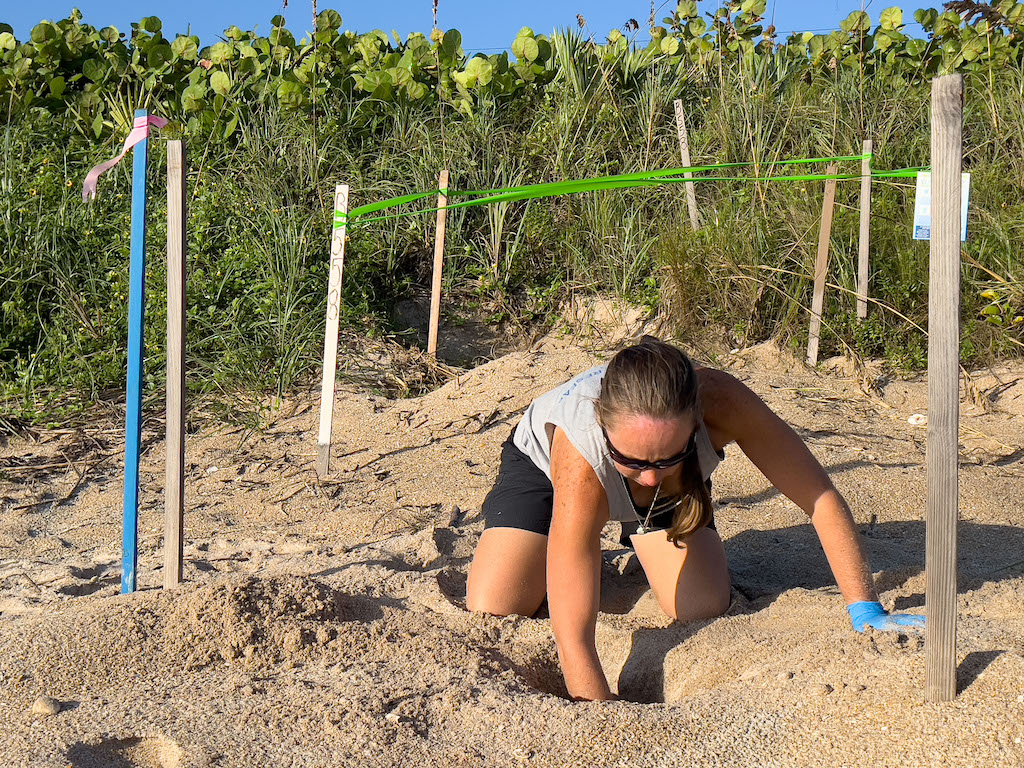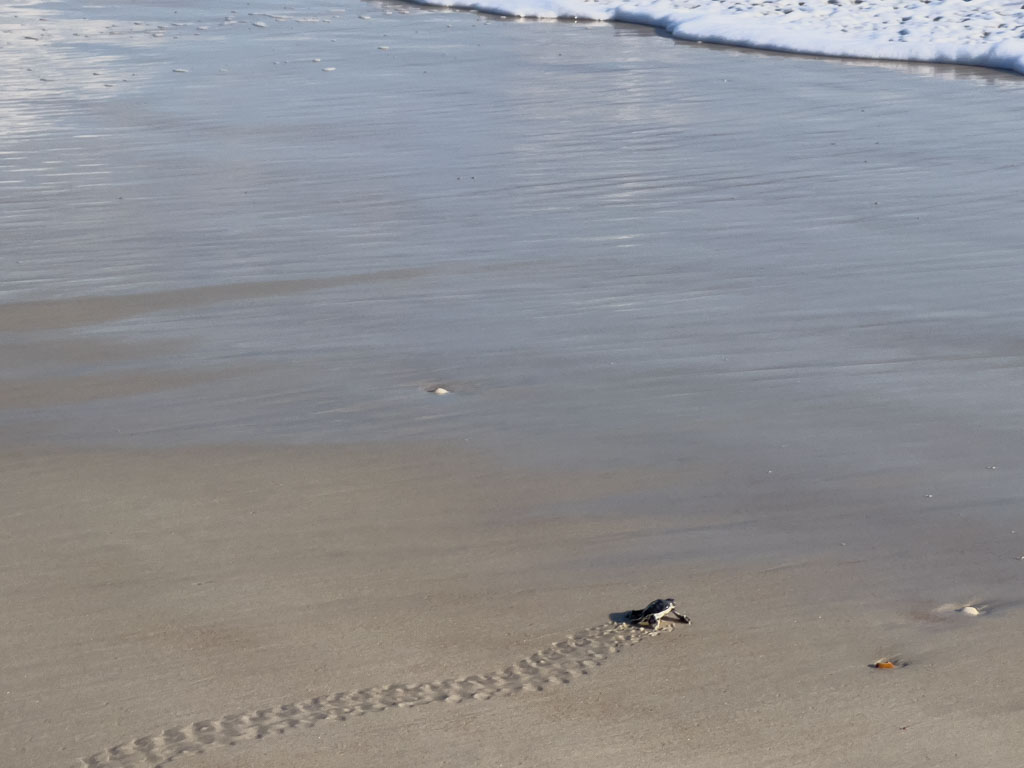(NEW SMYRNA BEACH, Fla.) — The early-morning, mid-September sun casts a warm glow on the coarse, red coquina sand along the southern shore of New Smyrna Beach, Florida. In the distance, an all-terrain vehicle motors along on the beach, making frequent stops. This time, as the vehicle idles, a woman hops out — mallet in hand — and pounds a stake securely back into the sand. It was a loosened corner of a cordoned off area protecting a sea turtle nest. A moment later, she was back in the ATV traveling along the remaining stretch of beach.
This quiet, yet diligent scene, has become customary for locals of this Central Florida surftown. The inspections of protected sea turtle nests continue in this fashion along the community’s entire 11 miles of beach, like they do every morning, during sea turtle nesting season that officially extends May through October. It’s a uniquely collaborative program among the state, county, private companies and local volunteers, which began in the 1980s as an assertive effort to protect the endangered leatherback and threatened green and loggerhead sea turtles.
It’s a familiar story, especially along the desirable shorelines of the Florida peninsula, of humankind and wildlife and their dueling habitats along the pristine coastline. In recent decades, it’s been the sea turtles on the losing end of that competition as housing developments have steadily edged out turtles’ nesting grounds alongside other threats including sea turtles entangled in commercial fishing lines and nets. Sea turtles are protected as either endangered or threatened under the Endangered Species Act.
But for biologist Jaymie Reneker, who sits behind the wheel of the ATV, it was the tail end of the 2022 nesting season that sparked a new level of optimism.
Typically, sea turtles, especially loggerheads, nest on a rotation laying four or five clutches, or sets of eggs, in one season then they take two or three years off before returning again, says Reneker, a former field biologist with Florida-based Ecological Associates.
The environmental consulting firm holds the permit for monitoring Florida’s sea turtles. These ups and downs in the numbers of nests are normal. For the New Smyrna Beach coast, that means an average of about 250 nests a year of all sea turtle species combined. In 2021, the number of nests hit a record 431 nests. Last year, that record was shattered with 714 nests recorded. It did not go unnoticed.
“Everybody was shocked,” Reneker says. “These numbers are incredible.”
A conservation win in the long climate battle
While the news is good, scientists are not convinced sea turtle species are completely out of danger. In fact, Jeanette Wyneken, a professor at Florida Atlantic University who studies sea turtle nesting behavior, told the New York Times in September that the warming climate could impact the ratio of male-to-female sea turtles with populations of male green sea turtles plummeting in recent years. Reneker agrees saying warming temperatures, which is a determining factor for the sex of turtles, can skew hatchling sex ratios to more females. And, she adds, warmer incubation temperatures can decrease hatchling success.
“If the nest environment is too hot and dry, turtles won’t develop and hatch,” Reneker says.
Other continued threats include the steady development along the coastline, which makes it hard for turtles to find places to nest. Also, with more coastal development comes more artificial lighting from structures, says Reneker. Despite local laws regulating residential light along the coast, the artificial lighting can confuse sea turtles that naturally orient to the brightest horizon. On a natural beach, that should be the moon reflecting off the ocean. Both nesting females and hatchlings can end up following the artificial light sources instead of heading straight to the water, Reneker says. That disorientation can be the difference between life and death.
“This expends a lot of valuable energy that hatchlings need to swim out to the Gulf Stream, [an ocean current in the north Atlantic Ocean],” says Reneker. “And, the nesting females need to lay eggs and return to the water.”

Biologist Jaymie Reneker (right), Jennifer Winters, protected species manager for Volusia County (center), and volunteer Jean Callaghan (left) on their morning rounds monitoring sea turtle nests in New Smyrna Beach, Florida. [Credit: Jennifer Taylor]
The 11-mile shoreline in New Smyrna Beach reflects a remarkable coexistence between nature and development. Protected sand dunes sit among oceanfront houses, condominium buildings and designated areas where motorists can drive on the beach. In 2022, this stretch, which is equally famous for its appeal to surfers and tourists as it is to sea turtles, yielded the most tallied sea turtle nests in 30 years of recordkeeping.
“I was anticipating a decent, high year. But, not this high of a year,” Reneker says.
So, what happened?
It’s a question that has scientists excited about decisions made in decades past.
Reneker and other scientists credit the uptick, which, by the way, is a trend the entire state is witnessing, to Florida’s sea turtle conservation efforts that have happened over the past 30 years. New Smyrna Beach is a small snippet of the state and considerably north of where higher densities of sea turtles typically nest, which is why its nest tallies are notable.
“For our numbers to be very high, I think is a good sign,” Reneker says. “[The sea turtles] are starting to come back. They’re starting to do what they’ve always done.”
Spikes like that in the data have scientists excited about the future.
“That up-and-down trend happens every few years,” Reneker says. “But, the trend itself has been going up since the program started.”
Reneker is referring to sea turtle protections in place at the federal and state levels combined with conservation efforts by counties, state parks, national parks, nonprofits, volunteer groups, and small companies. The conservation programs began back in the 1980s, and because sea turtles take 25 to 30 years to reach sexual maturity, they are just now starting to see the impact of the conservation efforts.
New Smyrna Beach also has its own protections working in the sea turtles’ favor: a Habitat Conservation Plan that is managed by Volusia County. That plan — a conservation zone along where driving is allowed on the north end of the beach — authorizes scientists, county officials and local volunteers to access the beach daily May through October to stake off sea turtle nests. Each morning, on the stretch of beach where driving is allowed, the trackers have first access to the beach. Once they’ve scanned the beach and placed protections around new sea turtle nests, they give the all-clear, and local beach patrols open the beach to the public.
“We are the first out every single morning. The beach doesn’t open to driving until we get everything marked. If we’re not done, the beach doesn’t open. It opens when we’re done,” Reneker says. The monitoring includes checking all the nests, marking new nests, and marking new crawls (when flipper tracks are spotted indicating when sea turtles have nested on the beach). The work makes Reneker hopeful about the plight of sea turtles in the United States.
“We’re seeing that general increase [in sea turtle nests],” Reneker says, adding “[The] increase is not strictly just being seen in Volusia County. It’s the entire state of Florida.”
Sea turtles have been around for thousands of years. What they do and how they do it doesn’t change. It’s instinctual. “They’re going to come up, dig their chamber, lay their eggs, [the eggs] hatch and turtles go to the ocean. Thirty years later, it happens all over again,” Reneker explains. “Our goal is to protect those eggs while they are incubating.”

Biologist Jaymie Reneker digs a hole to excavate a sea turtle nest. [Credit: Jennifer Taylor]
Back on the south end of the New Smyrna Beach coast, the ATV makes another stop and the three-person tracking team — led by Reneker — approaches a cordoned off sea turtle nest. Crouched down on her hands and knees, Reneker takes her right hand and begins digging. Before long, she locates the egg chamber. It’s deep, but not out of reach. With her arm extended into the nest all the way to her shoulder, Reneker slowly excavates the nest. Intact eggs. Hatched eggs. And then one by one, tiny, sand-covered green sea turtle hatchlings get a hand-up, if you will, on their journey to the sea.
But not before the team collects data.

A green sea turtle hatchling discovered during a turtle nest excavation. [Credit: Jennifer Taylor]
The loggerhead has nine distinct population segments (DPS) listed under the Endangered Species Act. In Florida, they are designated as “threatened” by the federal Endangered Species Act and as a federally designated “threatened species” by Florida’s Endangered and Threatened Species Rule and by Florida’s Marine Turtle Protection Act.
Recent research shows two beaches have more than 10,000 females nesting per year: South Florida in the U.S. and across the globe in Oman. Oman’s nesting population continues to decline, making Florida’s Atlantic coastline the most prominent loggerhead sea turtle nesting location in the world, according to NOAA Fisheries. It’s estimated that 90% of the worldwide loggerhead sea turtle species now nest in Florida.
The data points to protections
Scientists and volunteers throughout Florida have calculated how many potential hatchlings will make it to the ocean. Sea turtle excavations date back to the late 1970s, according to Niki Desjardin, director of operations at Ecological Associates. Currently, the Florida Fish and Wildlife Conservation Commission administers two sea turtle protection programs on behalf of the U.S. Fish and Wildlife Service — a statewide sea turtle nesting beach survey and an index nesting survey. The latter helps identify trends in the sea turtle populations in Florida.
The excavations help Florida scientists understand the impact that development is having on the species and their nesting habitat. Currently, sea turtle excavations are taking place on 215 Florida beaches encompassing 825 miles of coastline. Desjardin agrees that Florida’s collaborative efforts to protect sea turtles is making a difference. The loggerhead population has fluctuated, but is currently seeing an uptick, she says. For the leatherback and green sea turtles, says Desjardin, the trend continues to be “tremendously successful” over the past 10 to 15 years.
“We don’t know exactly what is causing that, but certainly increased protections for those species has helped,” Desjardin says.

Volunteer Jean Callaghan cradles a newly hatched green sea turtle discovered during a sea turtle excavation. [Credit: Jennifer Taylor]
“The plan is incredibly successful … and shows the ability to come together and create a plan that works for everybody,” Desjardin says.

Newly hatched green sea turtles are collected in a bucket waiting to be released into the ocean. [Credit: Jennifer Taylor]
Back on the beach, the team sorts the intact green sea turtle eggs in one pile. The hatched eggs are placed in another. And any hatchlings are collected in a small, black bucket. This is where the crucial work happens. The team counts the number of hatched and unhatched eggs. The data tells a somewhat incomplete story just like the number of nests tracked. It gives scientists an idea of how many hatchlings may make it out to the ocean.
After emptying the chamber, the unhatched eggs are put back. Reneker scoops up the bucket and walks toward the ocean, another intervention (shortening the path) that hopefully gives the hatchlings a greater chance for survival. With sterile gloves on both hands, she reaches for a hatchling. It fits in the palm of her hand. The moment is coming. The tide is coming. Reneker knows and somehow the little green sea turtle also knows what it’s supposed to do.

Biologist Jaymie Reneker releases green sea turtle hatchlings into the ocean. [Credit: Jennifer Taylor]

A green sea turtle hatchling makes its way to the ocean. [Credit: Jennifer Taylor]
It shouldn’t be surprising, but for Reneker it is. “The turtles … they don’t give up,” she says. “They’ll come back.”


